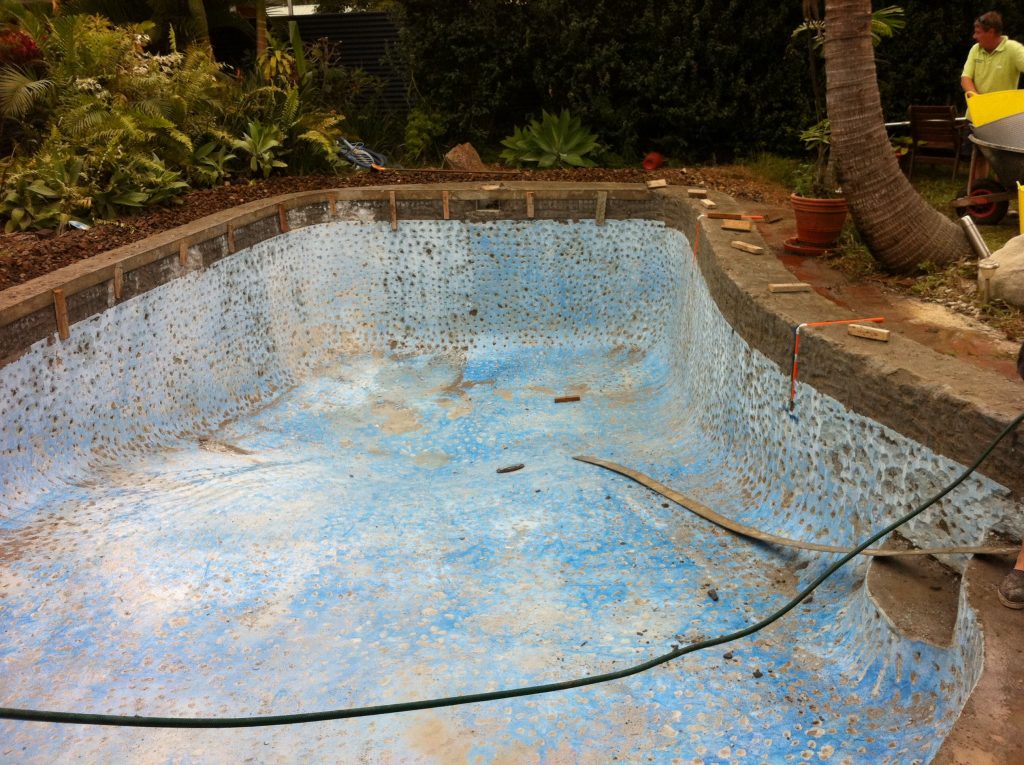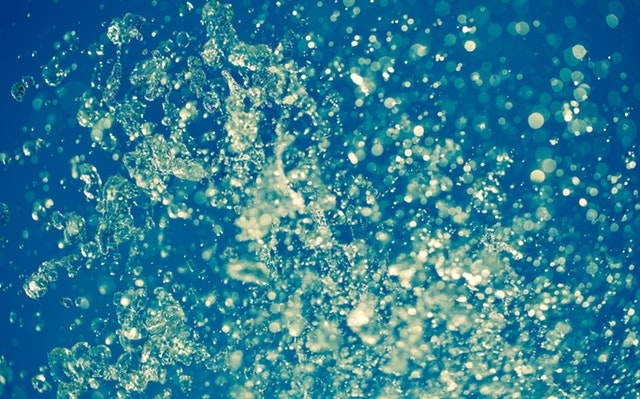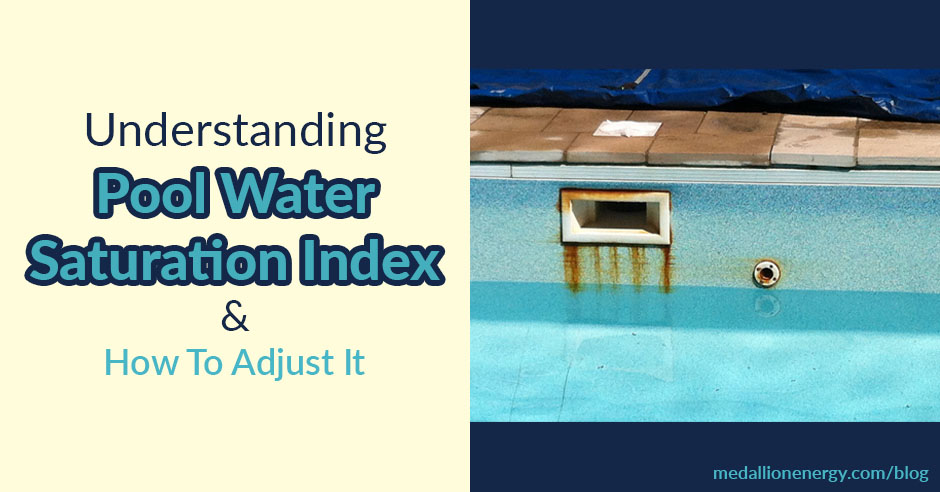Do you want the purest pool water possible? We’re not just talking balanced water, but PERFECTLY balanced water.
Crystal clear water, softer than liquid silk to the touch (if you’re using salt water chlorination). Water that resists all the common headaches like scaling and corrosion.
If that sounds appealing, keep reading. Because your pool water saturation index is the one thing standing between you, and perfect swimming pool water.
What is pool water saturation index
The Langelier Saturation Index, or pool water saturation index, measures how saturated your water is with metals and calcium. Specifically, it’s a number used to identify whether your water is corrosive, scale forming, or perfectly in balance.
More often than not, your water leans slightly towards either the corrosive or scaling side.
The LSI scale ranges between the values of -1 and +1. For good pool chemistry, the ideal range for water saturation falls between -0.3 and +0.3.
A negative LSI, which is anything less than 0.0 is considered corrosive, while a positive LSI (above 0.0) is scale forming.
That said, if you’re going for “perfectly” balanced water, then an LSI of 0.0 is your goal. This is known as equilibrium, and it’s the number you want to maintain to avoid scaling and corrosion for good.
For the most part, finding your pool’s LSI involves the same chemicals you measure when balancing your water. Except to calculate LSI properly, you need one other VERY important variable: temperature.
Temperature, as you may know, directly affects the efficiency of your pool chemicals. But to be more accurate, it has a major effect on the speed of chemical reactions taking place in the water.
For instance, hotter temperatures raise pH levels, which make it easier for calcium to come out of suspension and begin forming scales. On the other end, lower temperatures make it easier for corrosion to occur.
This is just one of many reasons why heating your pool is to your benefit.
Side note: For those wondering where the Langelier Saturation Index came from, here’s a quick history lesson. In the 1930s, Wilfred F. Langelier invented the LSI to address the widespread issue of corrosion and scaling in municipal water storage. The invention of LSI advanced water treatment and allowed for better handling, transport, and storage of water throughout plumbing and sewage facilities nationwide.
Related: 7 Cheap Ways To Heat Your Pool
Why is pool water saturation important



So why does it matter how corrosive or scale forming your water is anyway?
Here’s why:
Water that’s too corrosive can damage and break down your pool equipment, and your pool itself (plaster, vinyl liners, PVC pipes, and fixtures). Meanwhile, water that’s too rich in calcium, or scale forming, can clog up pipes and equipment with calcium deposits.
Neither corrosion or scaling spell out good things for your pool system and ultimately lead to expensive repairs and replacement costs.
And of course, this goes without saying, but the less corrosive or scale forming your water is, the healthier and better it is for your skin.
But here’s the funny thing about your pool water: it actually WANTS to be perfectly balanced.
When your pool water lacks calcium, it finds ways to get more…by any means. Whether it’s eating away at calcium in the plaster of your pool frame (etching), or just about anywhere else it can find it.
And once it has too much calcium, it’ll start getting rid of it. How? By depositing it into white scales all across the pool wall and in your pipes.
Metal buildup works in a similar way, where once there’s too much of it in your water, you’ll see deposits in the form of different colored stains.
Good LSI helps keep all of that in check.
Everything that affects LSI



As we mentioned earlier, LSI involves a lot of the same chemicals you measure when you’re testing your water. Of course, there are a few other variables that factor in. But don’t worry, we’re going over each one right now.
pH is what determines how much of an acid or base a liquid is. It also affects several of the other chemical reactions happening in your pool, like chlorination. For swimming pools, ideal pH ranges from 7.4 to 7.6. In reference to LSI, out of range pH levels can encourage corrosion or scaling to happen faster.
Total alkalinity mainly acts as a buffer, or “stabilizer” for pH. In other words, it helps reduce how much your pH levels fluctuate. This is why it’s usually best to test and adjust your Alkalinity before adjusting pH.
Calcium hardness indicates how much calcium is saturated into your water. Ideally, your calcium hardness should be on the lower end closer to 150 ppm for softer water, as higher levels lead to faster scaling (and harsher water).
Total Dissolved Solids is the number of minerals, metals, salts, and organic material dissolved into your water. It’s a great indicator of when to replace your pool water. Early warning signs of high TDS levels include pool stains, algae blooms, scaling, and chlorine demand.
Usually, the lower your TDS, the lower your LSI will be, and vice versa.
Temperature controls the speed of the chemical reactions happening in your water. Hotter temperatures can raise pH and cause chlorine level drops. Lower temperatures create ideal conditions for corrosion.
Related: Pool Stain Removal 101
How to calculate water saturation index
To calculate your pool water saturation index, you’ll need to use this chart:



Step 1) Test your water and measure the following levels:
- pH
- Water temperature (in Fahrenheit)
- Calcium Hardness
- Alkalinity
- Cyanuric Acid
- Total Dissolved Solids
Related: Balance and Test Your Water in 7 Easy Steps
Step 2) Use your chemical levels & the chart to identify each factor
Let’s do a quick example. Here’s the temperature and pool chemistry info for your imaginary pool:
- pH: 7.6
- Temperature: 84ºF
- Calcium Hardness: 200 ppm
- Alkalinity: 150 ppm
- Cyanuric Acid: 70 ppm
- Total Dissolved Solids: 2000 ppm
With that information, we can find which factors to use from the chart.
- Our water temperature is 84 degrees. If we match that value to the Temperature Factor column, we get 0.7. The Temperature Factor is 0.7
By using the chart to match values to their corresponding “Factor” column, we can find the rest of the factors.
- For a Calcium Hardness of 200 ppm, we get a Calcium Hardness Factor of 1.9
- An Alkalinity of 120 ppm, gives an Alkalinity Factor of 2.2
(If there’s CYA in your water, then use your pH level to find the Cyanurate Correction Factor.)
- Our imaginary pool’s pH is 7.6, so the Cyanurate Correction Factor is 0.33
- The Total Dissolved Solids level is 1500 ppm, which gives a TDS Factor of 12.29
Step 3) Plug the LSI factors from Step 2 into the following equation
(pH) + (Temperature Factor) + (Calcium Hardness Factor) + [(Alkalinity Factor) – (CYA Correction Factor)] – (TDS Factor) = LSI
Here’s what that equation looks like with your example pool:
(7.6) + (0.7) + (1.9) + [(2.2) – (0.33)] – (12.29) = LSI
Here’s how you solve the equation to get your pool water’s LSI:
- (7.6) + (0.7) + (1.9) + [(2.2) – (0.33)] – (12.29) = LSI
- Add 7.6 (pH) to 0.7 (Temperature Factor)
- 8.3 +(1.9) + [(2.2) – (0.33)] – (12.29) = LSI
- Add 8.3 to 1.9 (Calcium Hardness Factor)
- 10.2 + [(2.2) – (0.33)] – (12.29) = LSI
- Subtract 0.33 (CYA Correction Factor) from 2.2 (Alkalinity Factor)
- 10.2 + (1.87) – (12.29) = LSI
- Add 10.2 to 1.87 (1.87 is the sum of Alkalinity Factor minus CYA Correction Factor)
- 12.07 – 12.29 = LSI
- Subtract 12.29 (TDS Factor) from 12.07
- -0.22 = LSI
For your imaginary pool, the LSI is -0.22 which is great and considered balanced.
Based on this example, the easiest way to get the LSI closer to 0.0 is reducing the Total Dissolved Solids level to under 1000 ppm (usually by draining and replacing a bit of water).
Adjusting your pool water saturation index
The easiest way to adjust your pool water saturation index is testing and balancing your water. As you now know, your pool chemistry directly affects your water’s LSI. The more in balance your water is, the closer your LSI will be to 0.
To keep your water balanced, test it at least twice (3x is better) a week and make small adjustments as needed.
And remember to keep an eye on your pool water’s temperature – it controls the speed of all the chemical reactions happening in your pool. So for the most control over your pool chemistry. keep your water at a comfortable, neutral temperature (around 84 degrees).
Closing thoughts on pool water saturation index
The secret to keeping your LSI in check lies entirely in good pool chemical maintenance. And keeping your water balanced, fresh, and properly heated gives you the most control over it.
If you like this post, you might also like:
7 Things To Do To Your Pool After It Rains


